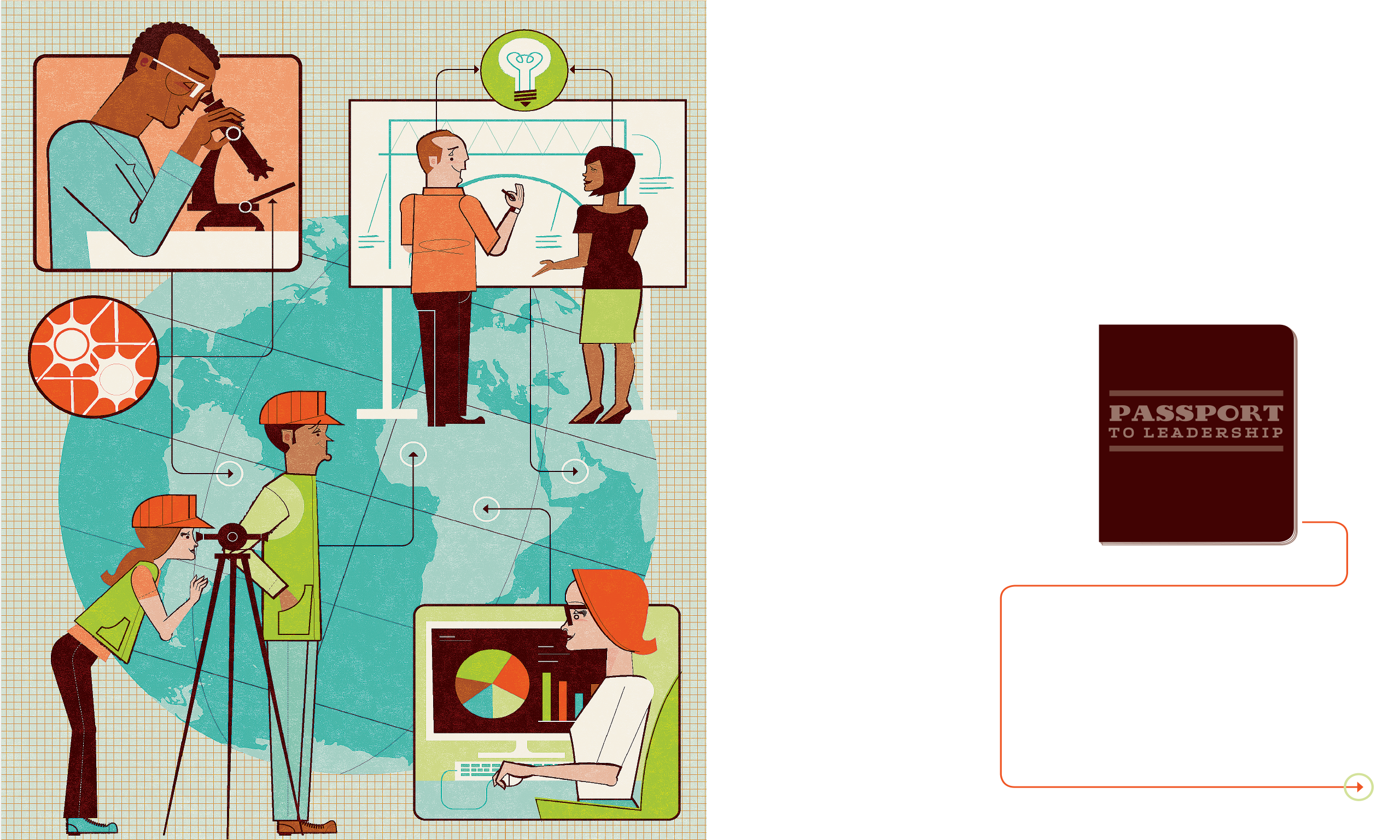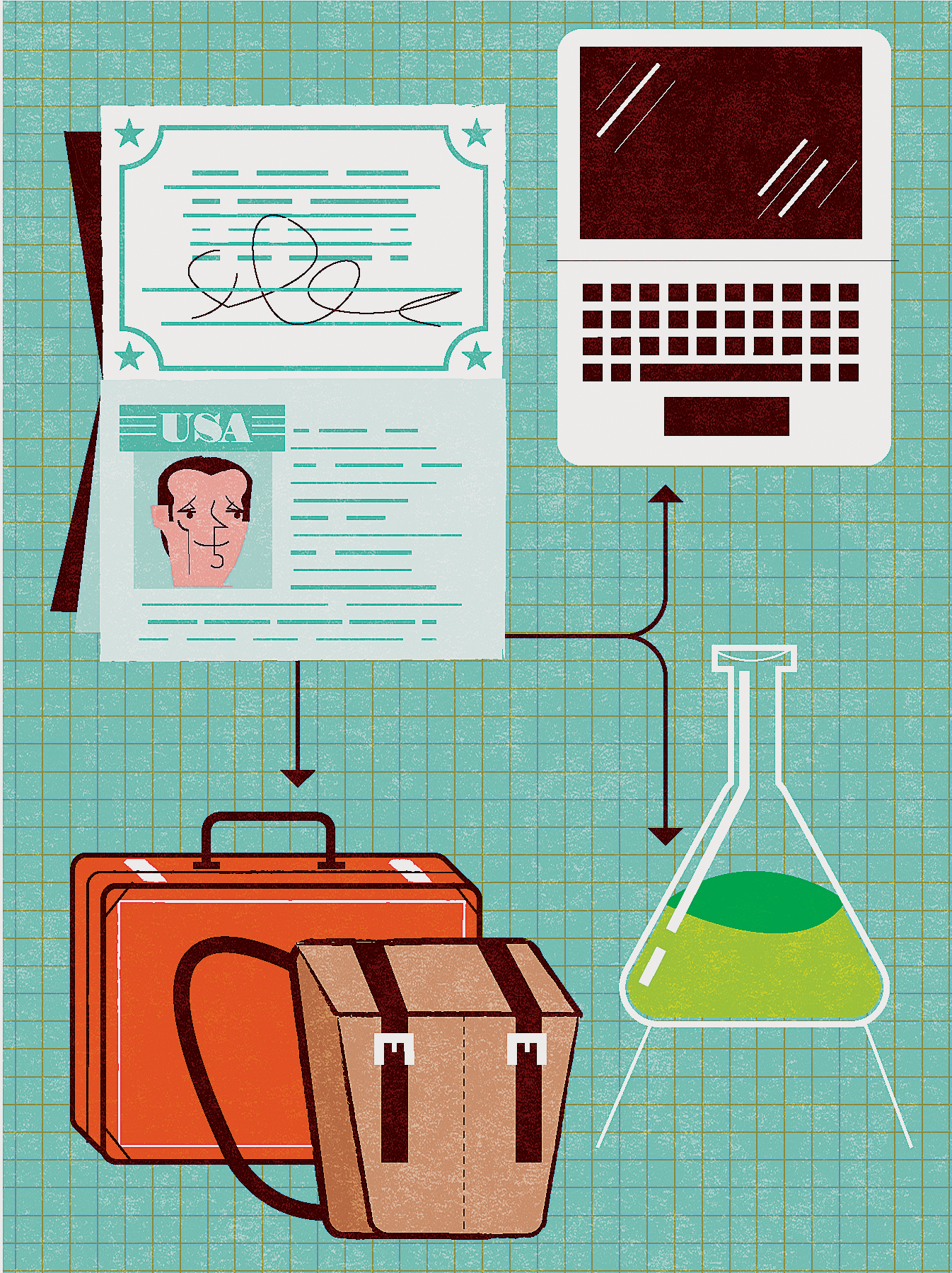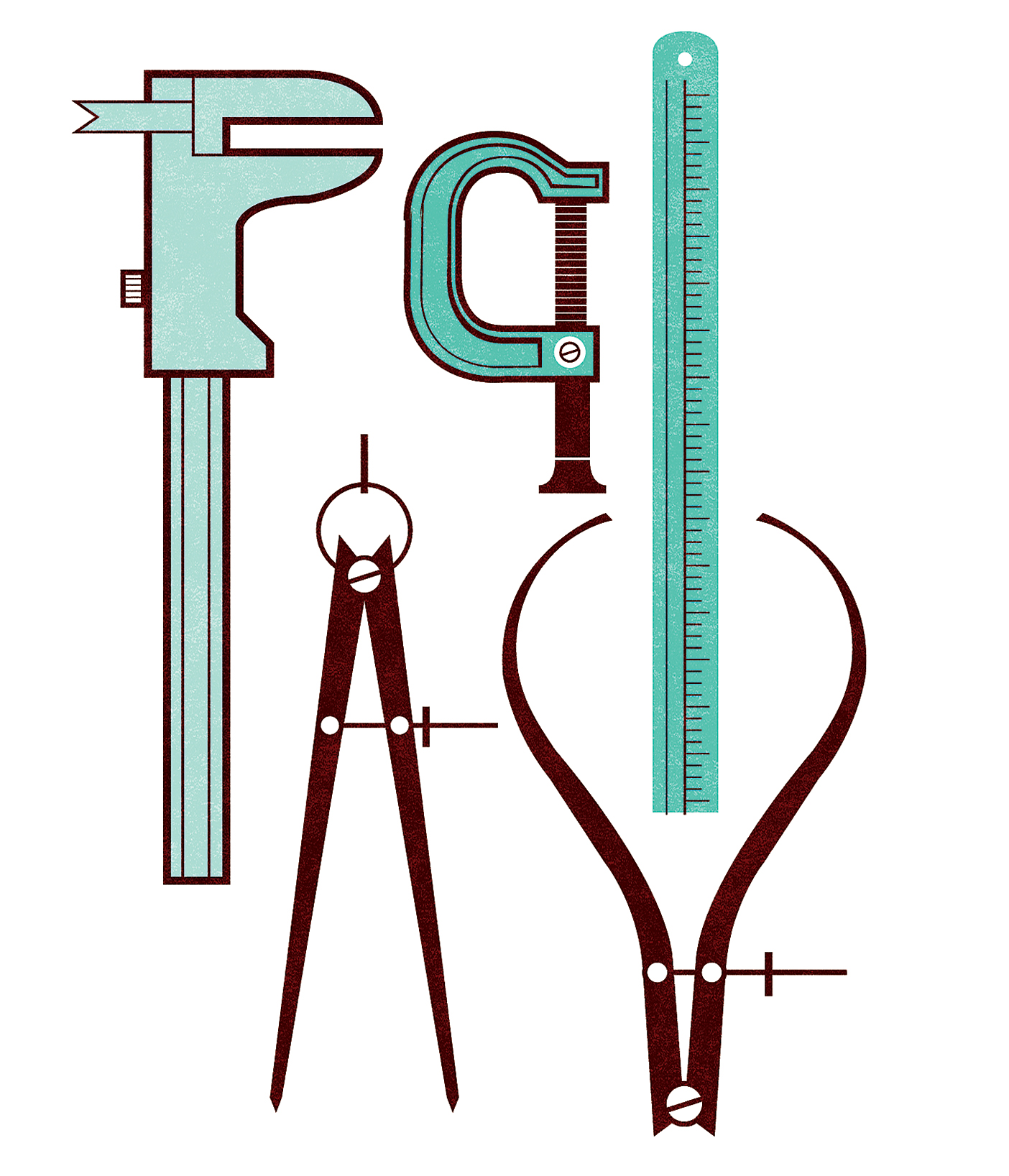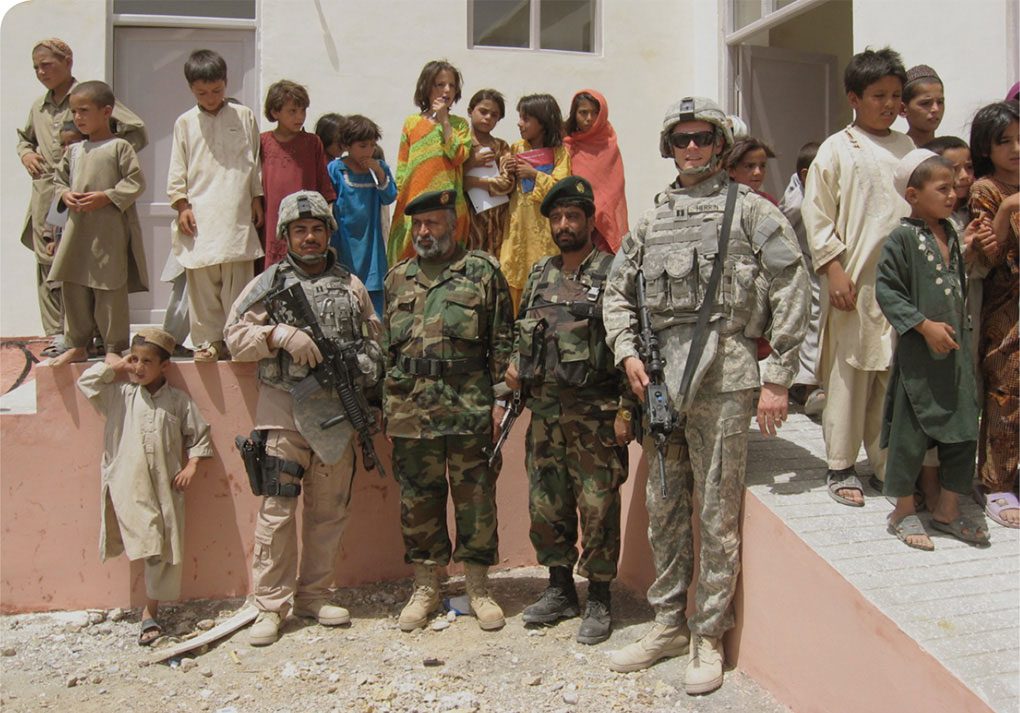Passport to Leadership

BYU’s college of engineering and technology builds leaders with a global mind-set.
By Sara D. Smith (BA ’10) in the Fall 2013 Issue
Illustrations by Scotty Reifsnyder
Raquel L. Eisele (’13) tipped over a freshly blended guacamole shake, deliberately pouring out puddles of green slush. The table became a colorful mess as her teammates helped, dribbling sauces and curries over every square inch. They had picked the sparsest corner of the hawker center—a Singaporean outdoor food court—to avoid attracting attention as they conducted some pretty gooey research.
Hawker centers, a Singaporean cultural icon, were set up in the 1950s to make street-food vending more sanitary. But they take a lot of effort to keep scrubbed—workers often struggle to clean up quickly after customers to maintain the high levels of sanitation Singaporeans expect.
An industrial design major, Eisele had gone to Singapore with a group of BYU engineering and technology students to learn how to develop products and to help solve problems in another country. Her group, including students from Penn State and the National University of Singapore, brainstormed ways to help workers wash tables more efficiently—keeping rags clean through multiple washings and using minimal soap to reduce cost for workers, who provide their own cleaning supplies. The students used their food-spattered table to test prototypes employing combinations of squeegees, brushes, and sponges.
“I love that kind of research,” says Eisele. “Talking to people to find out what they want changed, developing concepts, sketching ideas, making and testing prototypes—that’s how we brainstorm in design and engineering.”
Though in the country for just three weeks, Eisele left behind some great ideas—and took home real-life experience designing and leading in an international context.
“A big part of being a leader is knowing how to work with a group and being able to have your voice heard and also have other people’s voices heard,” says Eisele. She says her team was filled with leaders—leaders who worked through cultural and communication barriers to solve an engineering problem.
This is exactly the kind of experience the Ira A. Fulton College of Engineering and Technology wants to offer to as many students as possible. Eisele’s study abroad is one of 12 international engineering programs coordinated and subsidized by the college’s Weidman Center for Global Leadership, which sends budding engineers around the world.
Some students purify drinking water in Peru’s Lake Titicaca. Others help solve transportation problems in a small Mexican town with few streetlights. Information technology majors work in Taiwan, where most of the world’s computer parts are manufactured. Industrial design students head to Paris for an international design expo, and civil engineering students analyze the world’s largest structures, then travel to tour the buildings and meet the designers. About 25 percent of BYU engineering students have technical experience abroad before graduation—a huge portion, considering that at most engineering schools it’s only about 4 percent.
But Gregg M. Warnick (BS ’93, MTM ’94), director of the Weidman Center, isn’t satisfied. “We want 100 percent of our students to have an international experience,” he says.

Engineering Abroad
Created in 2011 with a $10 million donation from David N. Weidman (BS ’78) and his wife, Rachel Nielsen Weidman (BA ’77), the Weidman Center aims to turn BYU engineering students into distinctive employees and globally savvy leaders. From internship coordination to scholarships to free passport photos, the center removes roadblocks students may find in taking their education to another country.
“Engineering is now a global enterprise,” says Alan R. Parkinson (MBA ’03), dean of the Fulton College. “The Weidman Center for Global Leadership was set up to emphasize both the development of leadership skills and the development of global agility—the ability to work across different cultures and countries.”
Parkinson wants the college’s signature to be graduates who are ready for an industry that’s becoming more global every day—graduates like the man whose name the center carries. David Weidman, a chemical engineering graduate with an MBA from the University of Michigan, retired in 2012 as chairman and CEO of the Dallas-based Celanese Corporation, a Fortune 500 chemical company that manufactures the building blocks of everyday products like paint, cell phones, and artificial sweeteners.
Pairing technical skill with business acumen, Weidman built a career that took him across the globe. After being named CEO in 2004, Weidman led Celanese’s transition from a midsize company to a global industry leader traded on the New York Stock Exchange. About 80 percent of Celanese’s revenues now come from outside the United States.

When Weidman began his career, technology and consumer demand was such that engineering companies could find large enough markets by focusing on one geographic region. But as communication and technology advanced, regional specialization was no longer sufficient.
“I’ve seen the world move from being these islands, these pockets of isolated consumers, to a point where consumers are the same [around the world],” explains Weidman. “In recent years, companies that prosper—not just in the chemical industry but in every industry—understand that, and they’re focused on the global market.”
For him, the Weidman Center for Global Leadership is an investment in preparing BYU engineers to excel in that global market—to give them opportunities to learn and work abroad and to develop leadership skills.
The center coordinates the teaching and curriculum of a sophomore-level class in global leadership. It’s required for all students in the Fulton College, and it’s a general education option for students in any program; about a quarter of students who enroll come from other majors, from music dance theater to exercise science to physics. “Even if you never travel or work outside of a little bubble, you are going to meet people who act and think differently than you,” says Warnick, who teaches the course. Global awareness, he says, helps people learn to listen and communicate effectively with diverse people. “I think that’s pretty universal.”
BYU engineering and technology students face a lot of job competition, but Warnick says they can succeed by not only becoming strong technical engineers but also developing leadership skills and learning to work in a global environment. “That becomes the element distinguishing us from other universities throughout the world.” These twin characteristics of leadership and global agility are what the Weidman Center aims to bring to BYU’s engineers.
A Vision of Leadership
The Weidman Center teaches that excelling in a diverse environment—multilingual, multicultural, or multinational, in the engineering industry or not—begins with solid leadership skills.
“I have a list of about 50 [general leadership] attributes,” says Parkinson, mentioning skills like developing self-awareness, establishing credibility, and motivating work teams. “But a global leader is able to work in a diverse environment and guide a group of people to accomplish a common goal.”
Developing and achieving a vision marks the difference between a leader who enacts progress and a manager who keeps the status quo, says Weidman. “Leadership is the ability to think about what might be, to see the possibilities in the world,” he says. “It’s not only where you are right now, but it’s thinking about what might be in the future.”
Weidman’s career itself is an example. When he stepped to the helm of Celanese, he caught a vision of where it was headed. The company’s customer base was growing in China, and because chemicals are best manufactured close to where they will be used, building manufacturing plants there made sense.
“We determined that we would follow our customers, but we felt that it was important to be independent in order to control our technology, better serve our customers, and be stronger employers,” says Weidman.
In 2006, Celanese became the first American company in the chemical manufacturing industry to build its own facilities in China. Weidman’s vision expanded Celanese’s presence in Asia and made the company an industry leader.
“Dave was a visionary who said we were going to take the next bold step,” says Christopher W. Jensen (MA ’91), senior vice president of finance at Celanese. “It was a huge move for the company and the industry. It set the stage for a lot of things we’ve since done in China and in Asia in general. Dave is a revolutionary, forward-looking leader.”
Leaders of everything from corporations to PTA groups to church organizations often have little problem hashing out objectives, purposes, and visions. The problem is when organizations “leave it to the forces of nature on their own to move it forward,” says Weidman. “Those corporations are stuck in the status quo in a world that’s constantly changing.” Instead, leaders need to dedicate resources—money, time, employees, etc.—to accomplishing their plans.
The main resource invested in Celanese’s globalization was its leadership team, founded in what Weidman calls his Square Root Rule: “Dave’s view is that the square root of the number of people you have in your company is the number of people you need as ‘change agents’ leading the revolution,” explains Jensen. “In our case, we needed almost 100 change agents helping transform the company.”
“The [leadership] team had been involved in business across the globe,” adds Weidman. “They were capable of working in global environments with confidence and agility. That’s the type of engineers we want to graduate from BYU.”

Going Global
Peruvians use basic cook stoves built over fires, says mechanical engineering student Frederick C. Decker (’14). The problem is that these stoves are inefficient and send ash and smoke into the air. As part of a yearlong class in which students collaborate on a product to improve the quality of life in another country, Decker set out to improve the Peruvian stoves.
“We converted the waste heat into power and used it to power a fan back into the stove to increase the efficiency,” explains Decker. Right after taking winter-semester finals, he and his classmates took their prototypes to Peru on a two-week trip subsidized by the Weidman Center. There they collaborated with locals to perfect the design.
“It was their country, and they knew what they needed,” says Decker. “We didn’t want to come down and tell them what to do; we wanted to learn from them. We provided technical support for their ideas.”
Through international experiences, students like Decker take leadership and technical skills abroad to learn how to work with and in a foreign culture. “We learned how to design using their materials,” he says, taking account for things like the average Peruvian body height and socioeconomic conditions.
Warnick teaches students in his global leadership classes to avoid ethnocentrism—the judging of another culture based on the values and standards of their own culture. A global mind-set means remembering that “one’s own set of beliefs is one of many and realizing that it is neither superior nor inferior to others,” says Warnick.
The key to leading in a diverse environment, says Weidman, is recognizing that there is not a single right way to get things done—any number of plans or allocations of resources can realize an organization’s vision. A leader with a global mind-set finds what works best in different environments.
“When I lived in Stockholm, I found that the Swedes were motivated when they were made part of the plan from the very beginning,” remembers Weidman. “They needed to be a part of it; if they were handed instructions and told to go do it, or if they started with a plan that was already 80 percent developed, it wouldn’t work. But if they were part of the plan from the very beginning, they were highly motivated to achieve it, more so than other people.”
Weidman took different approaches with people he motivated and trained in other cultures: In his experience, he found that the Chinese often like to learn in a classroom with chairs and tables and with a manual and a competent instructor, while many Germans prefer “an active environment where they are learning on the job.”

“A global leader doesn’t have to know all of those little things about the different cultures,” says Weidman, “but they have to be aware that there are a lot of good ways of doing things; you just have to find the right one for that environment.”
Leaders for the World
A global mind-set combined with leadership and technical skills is a strong recipe for success in the engineering world. Civil engineering students Chad H. Larson (’13) and Seishi Yamagata (BS ’12) took their skills with Synchro, a traffic simulation program, to Guanajauto, Mexico, on an 11-day Weidman Center–sponsored trip. Because Guanajauto has been designated a World Heritage Site—considered by the United Nations to be part of humanity’s cultural heritage—there can be no traffic lights besides the city’s one signalized roundabout.
“The city had some problems with a few roundabouts and the stretches of roadway in between them,” says Larson. “In the morning and evening rush hours they’d have delays and backed-up traffic.” Working with engineering students from Mexico, Larson and his BYU classmates modeled solutions to improve traffic flow. Their research began with counting cars backed up at the roundabouts during peak traffic times.
“It was tedious,” laughs Yamagata, but it was also more effective than working from Provo. “It’s kind of hard to try to come up with alternative solutions without actually being there and seeing the situation ourselves.” Combining the BYU students’ skills with the modeling program and the Mexican students’ knowledge of their city, the groups created simulations—digital “prototypes” of possible solutions, like changing the timing on the signalized roundabout and adjusting the placement of U-turns.
Jumping into the project helped Larson practice cross-cultural teamwork. He was impressed with the Mexican students’ expertise and passion—unlike the BYU students, they weren’t participating for class credit. “It was more like volunteer work for them.”
Working with these students on a real-world problem in an international setting armed Larson and his classmates with greater technical skills, enriched leadership experience, and a more global mind-set—which is exactly why the college of engineering and technology sent them.
Larson says when students get out of the classroom, “you get to see with your eyes how the engineering principles you learned are applied to life, to society—and how they impact real people, the people that live there and drive on these roads. You learn about their culture and other ways of thinking.”
Feedback: Send comments on this article to magazine@byu.edu.




